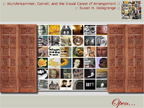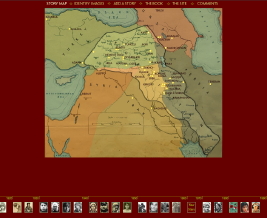When Revision Is Redesign: Key Questions for Digital Scholarship
Susan H. Delagrange
Production
Q: Does composing new media scholarship necessitate learning and designing with HTML, CSS, Flash, or other multimedia software?
For many scholars of digital media, the primary impediment to designing and publishing their research in digital form is time—time to learn software, time to keep up with technological change, time to become proficient in visual design principles and image manipulation, time to write and then translate that writing into a form suitable for digital distribution, the ticking tenure time-clock. During the conception, design and redesign of "Wunderkammer," I have dealt (am still dealing) with all of these. Yet I am committed to digital production for several reasons.
There is an on-going debate about what defines new media, but my working definition includes projects that are interactive, media-rich, and, most importantly, cannot be (as) meaningfully composed or published in nondigital form. The interactive visual design of "Wunderkammer" is absolutely necessary to enact my assertion that mobility and visuality are key constituents of the canon of arrangement. The difference between the Flash version and a print article is like the difference between a film and a screenplay. To be fully realized, both have to be performed.
Picture Projects, which designs and publishes digital documentaries on complex social issues, makes imaginative use of interactive media in its various collaborations. The organization worked with photographer Susan Meiselas to produce aka Kurdistan, a "borderless space" designed to "build a collective memory with a people who have no national archive." The web site features a map and a timeline that offer both geographical and chronological navigation. However the active points on the map have no names or titles, nor do the faces that make up the timeline. While the website includes some material from Meiselas' (2008) book Kurdistan: In the Shadow of History, it focuses primarily on stories (connected to the map) and photographs (connected to the timeline) that have been sent in by viewers. The site also includes an Unknown Image Archive which encourages viewers to help identify images so they may "reclaim [their] place in history." An interactive site such as this, in which the content is updated with viewer contributions and the site navigation imitates the lost-and-(sometimes)found history of the Kurds, further demonstrates the meaning-making potential of new media.
Interactive digital media open up new opportunities to “perform” our pedagogy as a productive, rhetorically rich art, and to compose texts and make meaning that are not possible in traditional print.
I am also convinced that digital production is a powerful heuristic in its own right. Mathematician friends say that working at the blackboard is more generative than trying to think through a complex problem. Compositionists too have long believed that the act of writing is a mode of learning; it is the putting down of words on a surface that generates thought. In an article on the value of making digital projects in order to learn how to teach visual rhetoric, Margaret Syverson (2001) referred to the digital composing process as evolutionary rhetoric, which nicely describes the recursive meaning-making activity of working between words, images, and the elements of formal design. And Jennie Edbauer Rice (2008) drew an extended analogy between digital production and (auto) mechanics to argue forcefully that designing interactive digital media, like the work of a good mechanic, is not merely instrumental; rather it is "the material practice of enactment" (p. 373), which includes the knowledge to both design and deploy smart, aesthetically pleasing, rhetorically effective, digital media.
This is not to say that every aspiring digital composer works, or should work, alone. Henry Jenkins (2006) argued that often the best solution to the varying degrees of experience and proficiency with digital media is collaboration. For example, "Pulling the Difference: Re-envisioning Journals' Negotiations of New Media Scholarship" by Patricia Webb Boyd (2008), the first piece published in the Inventio section of Kairos, demonstrated a fruitful collaboration between Boyd and Madeleine Sorapure, Inventio editor. Sorapure provided expertise in Flash and digital design to help Boyd make visible the form she had imagined for her article.
Collaborations such as this, between writers and designers, in which the designer works alongside the writer to visualize her argument and then realize that argument in a rhetorically appropriate form, are digital instantiations of other intensive collaborations between writers and illustrators, or lyricists and composers. However it is bad practice in digital writing studies for an author to hand off a written text to a designer to be transformed into a web page or a Flash movie without both collaborators being involved in the recursive design process. Design is intrinsic to an argument, not decoration for it, and must be part of the writing-imaging-designing process from Day One. When authors do not have the design expertise to handle production on their own, they must learn to ask enough questions of the designer to allow the design process to be generative.

